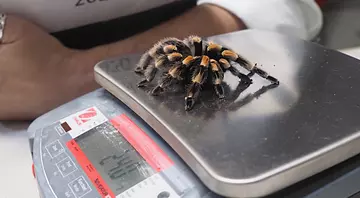

Love spiders? Visit our Mexican red-kneed tarantulas in our Tiny Giants area at London Zoo.
What do Mexican red-kneed tarantulas look like?
When fully grown, these spiders have a dark-coloured body with orange patches on the joints of their legs, giving them the name of a red-kneed tarantula. Like other arthropods, the red-kneed spider must shed its skin in order to grow as its exoskeleton can't stretch.
What do Mexican red-kneed tarantulas eat?
Red-kneed tarantulas are carnivores and prey on other animals, including insects, small mammals, birds and reptiles.

Where do Mexican red-kneed spiders live?
The Mexican red-kneed tarantula is native to the western faces of the Sierra Madre Occidental and Sierra Madre del Sur mountain ranges in Mexico.
What threats do Mexican tarantulas face?
Mexican red-kneed tarantulas are listed as vulnerable on the IUCN red list of threatened species, and they are poached unsustainably for the pet trade. A study made in collaboration with ZSL, also found they are threatened by habitat loss, mostly due to urban development. The growing number of roads being built presents a deadly obstacle for wandering males looking for a partner, and is contributing to population fragmentation.
ZSL has been part of a project using new technologies to track male tarantulas so we can learn more about how far they travel, and for how long, so that they can be better protected.
Spider facts:
- Female Mexican red-kneed tarantulas can live for up to 30 years, but the males tend to only live to around five.
- These spiders are extremely docile, preferring to avoid conflict with intruders. If harassed, the tarantula will kick urticating hairs at the threat, causing irritation in the eyes and throat.
